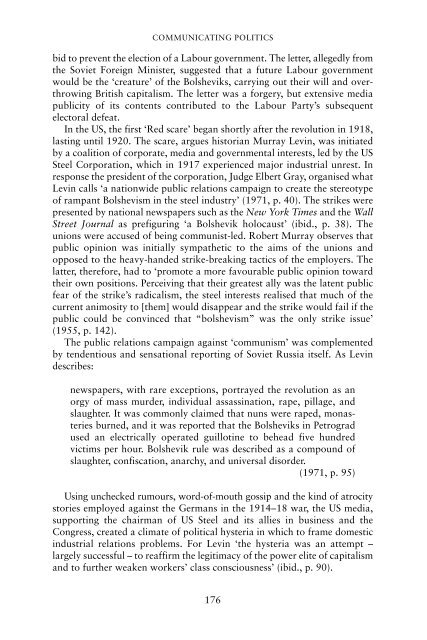20130412164339753295_book_an-introduction-to-political-communication
20130412164339753295_book_an-introduction-to-political-communication
20130412164339753295_book_an-introduction-to-political-communication
Create successful ePaper yourself
Turn your PDF publications into a flip-book with our unique Google optimized e-Paper software.
COMMUNICATING POLITICS<br />
bid <strong>to</strong> prevent the election of a Labour government. The letter, allegedly from<br />
the Soviet Foreign Minister, suggested that a future Labour government<br />
would be the ‘creature’ of the Bolsheviks, carrying out their will <strong>an</strong>d overthrowing<br />
British capitalism. The letter was a forgery, but extensive media<br />
publicity of its contents contributed <strong>to</strong> the Labour Party’s subsequent<br />
elec<strong>to</strong>ral defeat.<br />
In the US, the first ‘Red scare’ beg<strong>an</strong> shortly after the revolution in 1918,<br />
lasting until 1920. The scare, argues his<strong>to</strong>ri<strong>an</strong> Murray Levin, was initiated<br />
by a coalition of corporate, media <strong>an</strong>d governmental interests, led by the US<br />
Steel Corporation, which in 1917 experienced major industrial unrest. In<br />
response the president of the corporation, Judge Elbert Gray, org<strong>an</strong>ised what<br />
Levin calls ‘a nationwide public relations campaign <strong>to</strong> create the stereotype<br />
of ramp<strong>an</strong>t Bolshevism in the steel industry’ (1971, p. 40). The strikes were<br />
presented by national newspapers such as the New York Times <strong>an</strong>d the Wall<br />
Street Journal as prefiguring ‘a Bolshevik holocaust’ (ibid., p. 38). The<br />
unions were accused of being communist-led. Robert Murray observes that<br />
public opinion was initially sympathetic <strong>to</strong> the aims of the unions <strong>an</strong>d<br />
opposed <strong>to</strong> the heavy-h<strong>an</strong>ded strike-breaking tactics of the employers. The<br />
latter, therefore, had <strong>to</strong> ‘promote a more favourable public opinion <strong>to</strong>ward<br />
their own positions. Perceiving that their greatest ally was the latent public<br />
fear of the strike’s radicalism, the steel interests realised that much of the<br />
current <strong>an</strong>imosity <strong>to</strong> [them] would disappear <strong>an</strong>d the strike would fail if the<br />
public could be convinced that “bolshevism” was the only strike issue’<br />
(1955, p. 142).<br />
The public relations campaign against ‘communism’ was complemented<br />
by tendentious <strong>an</strong>d sensational reporting of Soviet Russia itself. As Levin<br />
describes:<br />
newspapers, with rare exceptions, portrayed the revolution as <strong>an</strong><br />
orgy of mass murder, individual assassination, rape, pillage, <strong>an</strong>d<br />
slaughter. It was commonly claimed that nuns were raped, monasteries<br />
burned, <strong>an</strong>d it was reported that the Bolsheviks in Petrograd<br />
used <strong>an</strong> electrically operated guillotine <strong>to</strong> behead five hundred<br />
victims per hour. Bolshevik rule was described as a compound of<br />
slaughter, confiscation, <strong>an</strong>archy, <strong>an</strong>d universal disorder.<br />
(1971, p. 95)<br />
Using unchecked rumours, word-of-mouth gossip <strong>an</strong>d the kind of atrocity<br />
s<strong>to</strong>ries employed against the Germ<strong>an</strong>s in the 1914–18 war, the US media,<br />
supporting the chairm<strong>an</strong> of US Steel <strong>an</strong>d its allies in business <strong>an</strong>d the<br />
Congress, created a climate of <strong>political</strong> hysteria in which <strong>to</strong> frame domestic<br />
industrial relations problems. For Levin ‘the hysteria was <strong>an</strong> attempt –<br />
largely successful – <strong>to</strong> reaffirm the legitimacy of the power elite of capitalism<br />
<strong>an</strong>d <strong>to</strong> further weaken workers’ class consciousness’ (ibid., p. 90).<br />
176
















